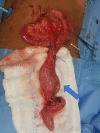Rare paediatric case of agenesis of the vermiform appendix, ileal duplication and sickle cell disease
- PMID: 35580950
- PMCID: PMC9114869
- DOI: 10.1136/bcr-2021-248181
Rare paediatric case of agenesis of the vermiform appendix, ileal duplication and sickle cell disease
Abstract
This study reports an exceptional case of a 14-year-old girl with sickle cell disease that was diagnosed with agenesis of the vermiform appendix and ileal duplication. Both consist of extremely rare gastrointestinal malformations whose association has never been described. The preadolescent girl presented with abdominal pain and vomiting, and the ultrasound was suggestive of acute appendicitis. Surgical findings were agenesis of the vermiform appendix and a T-shaped ileal malformation with inflammatory changes. The patient underwent resection and ileal end-to-end anastomosis. Histopathological evaluation identified an ileal duplication, with small bowel and colonic mucosa, no communication to the adjacent ileum and ischaemic changes. At 8-month follow-up, the patient was asymptomatic.
Keywords: Congenital disorders; Gastrointestinal surgery; Haematology (incl blood transfusion); Paediatric Surgery.
© BMJ Publishing Group Limited 2022. No commercial re-use. See rights and permissions. Published by BMJ.
Conflict of interest statement
Competing interests: None declared.
Figures






Similar articles
-
Colonoscopy diagnosis of recurrent abdominal pain in a 4-year-old boy with intestinal duplication cyst involving colon, appendix, and ileum: a case report.J Med Case Rep. 2024 Sep 23;18(1):444. doi: 10.1186/s13256-024-04780-0. J Med Case Rep. 2024. PMID: 39307876 Free PMC article.
-
Duplication of the vermiform appendix in an adult patient.Ann R Coll Surg Engl. 2014 Jul;96(5):e16-7. doi: 10.1308/003588414X13946184900246. Ann R Coll Surg Engl. 2014. PMID: 24992405 Free PMC article.
-
Double acute appendicitis in appendical duplication.Ulus Travma Acil Cerrahi Derg. 2013 Jan;19(1):83-5. doi: 10.5505/tjtes.2013.80557. Ulus Travma Acil Cerrahi Derg. 2013. PMID: 23588988
-
Ileal duplications in adults. Presentation and treatment.Arch Surg. 1994 Jun;129(6):659-61. doi: 10.1001/archsurg.1994.01420300103018. Arch Surg. 1994. PMID: 8204043 Review.
-
Left-sided appendicitis: review of 95 published cases and a case report.World J Gastroenterol. 2010 Nov 28;16(44):5598-602. doi: 10.3748/wjg.v16.i44.5598. World J Gastroenterol. 2010. PMID: 21105193 Free PMC article. Review.
References
-
- Collins DC. A study of 50,000 specimens of the human vermiform appendix. Surg Gynecol Obstet 1955;101:437–45. - PubMed
-
- Vieira EPL, Bonato LM, Silva GGPda, et al. . Congenital abnormalities and anatomical variations of the vermiform appendix and mesoappendix. Journal of Coloproctology 2019;39:279–87. 10.1016/j.jcol.2019.04.003 - DOI
Publication types
MeSH terms
LinkOut - more resources
Full Text Sources
Medical
